Lehmann's poison frog facts for kids
Quick facts for kids Lehmann's poison frog |
|
|---|---|
 |
|
| Conservation status | |
| Scientific classification | |
| Synonyms | |
|
Dendrobates lehmanni Myers and Daly, 1976 |
The Lehmann's poison frog or the red-banded poison frog (Oophaga lehmanni) is a small, brightly colored frog. It belongs to the Dendrobatidae family, also known as poison dart frogs. This frog lives only in a small part of western Colombia. Its natural home is in tropical rainforests found on mountainsides. Sadly, this frog is in danger because its home is disappearing, and people collect it illegally for the pet trade. Because of this, the IUCN (International Union for Conservation of Nature) says it is "critically endangered". The frog was named after Federico Carlos Lehmann, a Colombian scientist who worked to protect nature.
Contents
What Does It Look Like?
Lehmann's poison frog has smooth skin. Its bright colors are a warning sign to animals that might want to eat it. This warning is called aposematic colouration. It tells predators that the frog is not good to eat. These frogs can be red, orange, or yellow. Their main body color is black or dark brown. This dark color makes the two bright, wide bands around their body stand out. They also have colored bands on their legs.
The first toe on their foot is shorter than the second. Male frogs have shiny silver tips on their toes. These frogs grow to be about 31 to 36 millimeters (about 1.2 to 1.4 inches) long.
This frog looks very much like the harlequin poison frog (Oophaga histrionicus). These two types of frogs can even have babies together. Because of this, scientists are still discussing if they are truly different species. Also, the calls that male frogs make sound different between groups living in the north and groups living in the south.
Where Does It Live?
Lehmann's poison frog lives only in Colombia. You can find it in the tropical forests near the Anchicayá River. This area is west of Dagua in the Valle del Cauca Department. It is also found in one spot in the Chocó Department. All these places are on the slopes of the Cordillera Occidental mountain range.
These frogs live at heights between 600 and 1,200 meters (about 1,970 to 3,940 feet) above sea level. There are several separate groups of these frogs. The total area where they live is very small, less than 10 square kilometers (about 3.9 square miles).
Reproduction and Life Cycle
Lehmann's poison frog is diurnal, meaning it is active during the day. It mostly eats small insects. You can find these frogs on the forest floor or in low plants. They usually breed at the end of the rainy season.
First, the male frog finds a good spot and calls loudly to attract a female. The female then lays a few large eggs on leaves. These leaves are usually up to 120 centimeters (about 4 feet) above the forest floor. The male then fertilizes the eggs. He takes care of them by keeping them moist and turning them sometimes.
After two to four weeks, the male carries the newly hatched tadpoles on his back. He places each tadpole by itself into small, temporary pools of water. These pools can be in hollows of trees, in water-filled bromeliad plants, or in hollow bamboo stalks. The tadpoles grow in these pools. The female frog comes back regularly to lay unfertilized eggs in the water. These eggs become food for the tadpoles. If there are many tadpoles in one water pool, they might even eat each other.
In the wild, Lehmann's poison frogs are poisonous. However, if they are raised in captivity, they lose their poison. This is because their poison comes from the specific insects they eat in their natural habitat.
Protecting This Frog
Lehmann's poison frog lives in a very small area of Colombia. It is fully protected in its home country. The IUCN lists it as "critically endangered", which means it faces a very high risk of becoming extinct. It is also listed on CITES Appendix II, which means its trade is controlled to prevent it from becoming more endangered.
This frog used to be common in its tiny home range. But recent studies show it is now very rare. The biggest dangers to its survival are the destruction of its habitat. This happens because of logging (cutting down trees) and illegal farming. People also illegally collect these frogs to sell them as pets.
The Lehmann's poison frog lives in the Parque Nacional Natural Farallones de Cali, a national park. To help stop the illegal collection of these wild frogs, a special farm has been started in Colombia. This farm breeds Lehmann's poison frogs and other Colombian poison frogs in captivity. This provides legal frogs for the pet market. It also helps local communities earn money, which encourages them to protect the frogs instead of harming them.
See also
 In Spanish: Oophaga lehmanni para niños
In Spanish: Oophaga lehmanni para niños


